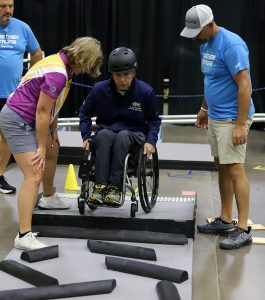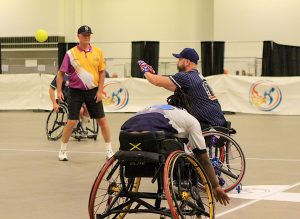NVWG’s Obstacle Course Known As Slalom Adds Two New Items
By John Groth
Human Engineering Research Laboratories (HERL) founder and wheelchair athlete Rory Cooper shook up the National Veterans Wheelchair Games (NVWG) obstacle course known as slalom a little bit.
It’d been a few years since the event had added any new obstacles. So, he made it happen.
Cooper and his team helped design two new crazy obstacles — a roller coaster-like swing for the higher classification athletes and a series of swinging pool noodles for the lower classifications — to conquer at the 44th NVWG inside the Minneapolis Convention Center in Minnesota.

The Games, which started this past Thursday and run through Tuesday, are back in Minneapolis for the first time in 20 years. Cooper had heard athletes wanted some more challenges, which hadn’t been implemented in a couple years. He delivered.
“To bring some new obstacles and create some excitement around the slalom, both for the athletes and the spectators,” he says of why he created both obstacles. “The feedback seems to be pretty positive.”
The first new obstacle — a roller coaster swing obstacle — is like a mining car and designed on the obstacle course for those with lower level injuries. Competitors start the event with it, and its designed to challenge their balance.
It’s made of wood and aluminum and designed to sit on the floor. Athletes have to use a rope to pull themselves inside and then swing from one side, to the other side and then back to the middle. Cooper describes it like a tube, and there’s 2-inch tubing rails with welded struts in between.
“The goal is to just, I guess, get up to where you have to gain a little faith in your balance and working on these skills of getting on and off the platform and make it a little exciting,” Cooper says.
Cooper says athletes had wanted a zipline for the obstacle course. And they started off designing that, but they realized the zipline wouldn’t work because it would only be a straight line and would depend on the event center’s ceiling height. So, they changed ideas and came up with the roller coaster mining car obstacle. Cooper says it took engineers about six months to come up the final design, and the fabrication took about a month.
NVWG veteran athlete and Army veteran Chris Hull has participated in the obstacle course known as slalom 10 times over the years.
Hull served from 2001 to 2005 as a mechanic, sustaining a level C6 spinal cord injury in a February 2004 motor vehicle accident as a passenger in Mobile, Ala.
Hull’s eyes widened when he first got on the new obstacle, but he loved it and didn’t have too much of a problem with it.
“The new roller coaster is super cool. I mean, it’s visually scary, but it’s actually a little fun ride,” Hull says. “You had to get the right amount of push to touch the far end of the obstacle and then let it completely stop without pushing too hard on the other side before you could get off.”
Then, there’s the moving pool noodles. Cooper says he wanted to come up with a difficult obstacle for the power chair or quadriplegic competitors and came up with a moving pool noodle system. The pool noodles are connected to drill bits up on a beam, and the drill spins the noodles.
“So, the pool noodles is really just about knowing your chair, how big it is, where you are in space and timing, getting the timing right,” Cooper says.
PVA Puerto Rico Chapter member Jose Ortiz was the first one in his classification to take on the pool noodles on Sunday morning. At 69 years old, the Army veteran is still going strong.
Ortiz served from 1983 to 1987 as a helicopter crew chief before sustaining a level C5 injury in May 1987 from a car accident on post in Fort Bragg in North Carolina.
He says the new obstacle, and the event as a whole, was fun.
“I mean, we all thought we were going to be hit by it, but I was the first one to go,” says Ortiz, who lives in Guaynabo, Puerto Rico. “And they said I went, like, kind of fast and didn’t get hurt. So, they say, ‘Wow, he got lucky. He didn’t get hurt.’ But every time somebody else went, they went through it, they didn’t get hurt.”
Cooper says they had to create a tool that’s self-powered because there was no outlet nearby for a cord. Additionally, the tool had to be able to be disassembled easily so it could be shipped from Games to Games and volunteers could put it together without issues.
“I wanted to put this out because I wanted a dynamic obstacle. Just like when you’re going down the sidewalk, there’s people on the sidewalk, that kind of thing,” Cooper says.
Twins Power To All-Star Game Softball Title
Later Sunday night, the Minnesota Twins wheelchair softball team put on a dynamic power show in the NVWG’s all-star softball game.
They took on the NVWG All-Stars and rolled to a 24-2 five-inning victory inside the Minneapolis Convention Center in Minnesota.

The NVWG All-Stars featured players selected by their NVWG peers, with some having played in last year’s all-star game and some being selected this year.
First-time NVWG All-Star Julie Casal says it was a major honor for her. The 54-year-old Marine Corps veteran and PVA South Florida Chapter member served from 1992 to 1994 in aviation ordinance and sustained a spinal cord injury from a fall during training.
This marks her third year attending the NVWG and first time playing in the all-star game. She was grateful and had a blast throughout the event and at the all-star game.
“But, yeah, playing softball … it’s awakened something in me that I didn’t think I’d ever be able to feel again,” Casal says. “You know, I love sports. Sports has always been a part of my life, whether it’s weightlifting or, you know, just being active. And, you know, with my injury, it’s been limited. So, adaptive sports has really changed my life, for sure.”
She learned plenty watching the Twins — and others on her team, too.
“Oh my gosh. It’s inspiring the way people can use their chair, the way that they move, how fast and everything. It’s not limiting. It’s not limiting at all,” Casal says. “And I just hope to be able to start learning to play sports this way.”